Research Article - (2018) Volume 4, Issue 1
Sanaa M Solyman1,2, Elsharaky EA1 and Amira E El-Tabey1*
1Egyptian Petroleum Research Institute, Ahsmed El-Zomor Street, El Zohour Region, Nasr City, Cairo 11727, Egypt
2AL-Ghad International College for Applied Medical Sciences, Dammam, Kingdom of Saudi Arabia
*Corresponding Author:
Amira E El-Tabey
Egyptian Petroleum Research Institute
Ahsmed El-Zomor Street, El Zohour Region
Nasr City, Cairo 11727, Egypt
Tel: +20 2 22745902
E-mail: amiraelarbi@yahoo.com
Received Date: June 03, 2017; Accepted Date: December 15, 2017; Published Date: January 01, 2018
Citation: Solyman SM, Elsharaky EA, El-Tabey AE (2018) In situ Catalytic Bulk Copolymerization of Maleate Surfmer-Methyl Methacrylate Using TiO2 and V2O5 at Different Conditions. Polym Sci Vol l.4 No.1:3
DOI: 10.4172/2471-9935.100031
Non-ionic Maleate surfmer (M1) prepared via ring opening reaction of maleic anhydride followed by esterfaction with polyethylene glycol. Surfmer was homopolymerized and copolymerized with methyl methacrylate (M2) at different conditions using TiO2 and V2O5 as catalysts in presence of O2 or N2. The chemical structure of the prepared surfmer was confirmed by FTIR, 13C and 1HNMR. The produced copolymers was also confirmed and characterized by Gel Permeation Chromatography (GPC) after cleaning polymers. Also, thermal gravimetric analysis (TGA) indicated higher thermal stability for M1M2TN and M1M2VO composites relative to pure PMMA. Scanning and transmission electron microscope (SEM and TEM) for PMMA and M1M2TN may confirm homogeneous and controlled enchainment of M1-M2 copolymer using TiO2 at the optimum conditions. The polymer conversion% was calculated and discussed. The optimum conditions resulted in 64.2% and 63.8% conversion using 20% TiO2 in N2 and 10% V2O5 in O2 respectively at 80°C after 4h with M1/M2 molar ratio of 1:1.The interfacial tension properties for the prepared surfmer and its copolymer was evaluated.
Keywords
Catalytic copolymerization; Maleate surfmer; Methyl methacrylate; Interfacial Tension; HNMR
Introduction
A significant number of studies have been undertaken on the polymerization of surfmers. Surfmers molecules present the advantage of combining the physical behavior of surfactants with the reactivity of monomers [1-3]. A wide variety of surfmer structures that differ with respect to polar functional groups (that is, hydrophilic and lipophilic balance) and the location of the polymerizable moiety have been reported. Examples include anionic, cationic, zwitterionic and nonionic surfactants [4-7]. The conventional polymerizable compounds that have been used include styrene, acrylic, methacrylic, and acrylamides [8-10]. The polymerizable surfactants are interesting in various fields. Several investigations have been carried out on maleic anhydride copolymers to be used as polymeric surfactants [11-13]. It was asserted for many years that 1,2-disubstituted ethylene does not polymerized, while maleic anhydride shows only a small tendency for radical polymerization [14]. Braun et al. [15] used various radical initiators to polymerize maleic anhydride; they observed partial decarboxylation and obtained a polymer which consists mainly of cyclopentanone derivatives. Heseding and Schneider [16] prepared maleic anhydride homopolymer by γ-irradiation. The polymer obtained by initiation via irradiation showed the anhydride structure without decarboxylation and discoloration. These results were in good accord with the findings from the work of Lang et al. [17]. Synthesized catalysts for industrial purposes consume a billion-dollar and account for the manufacture of 60% of chemicals that are utilized for most chemical transformations. Catalytic processes enable the production of many substances such as polymers, plastics, pharmaceuticals, detergents and many others [18-23]. For example, fabricated electrospun TiO2 has been designed, synthesized and used as green catalyst for save chemical process by Shrikant et al. [24].
Polymer-inorganic nanocomposites have a great attention recently due to their importance in different fields. It is known that TiO2 and V2O5 have good thermal and photo-catalytic activities in different chemical processes such as polymerization and environmental treatment reactions [25,26]. Also nano-TiO2 has bioactivity behaviors and thus polymer-TiO2 nanocomposites can be used in industrial and medical areas [27-29]. The functionality of PMMA/CaSO4 nanocomposites has been studied to be used as support for gentamicin antibiotic in bone substitute material and antibiotic vehicle [30]. Maleic anhydride (MA)- copolymers have been used as polymer-drug conjugates [31,32]. These copolymers are usually prepared in organic solvents which have cytotoxicity effect. The simple maleate surfmer (i.e. the neutralized hemi ester of a fatty alcohol) was used to prepare seeds of polystyrene latex which were grown with a shell of filmforming polymers [33].
This investigation describes a novel method for catalytic copolymerization of nonionic maleate surfmer with methyl methacrylate using in situ bulk polymerization technique to keep away from terrible effects of organic solvent. Copolymerization process was carried out using TiO2 and V2O5 in presence of O2 or N2 atmosphere at different reaction temperature, reaction time and molar ratios of monomers. Also, the mechanism of this reaction with and without catalyst was estimated.
Experimental Section
Materials
All chemicals were purchased from Aldrich Co. First of all, linear hexanol was dried using magnesium sulphate (MgSO4) then distilled under atmospheric pressure. Also, maleic anhydride (MA) was refluxed with chloroform and filtered to remove any traces of maleic acid. Finally, the product was then crystallized three times from chloroform to yield white needles with a melting point of 53°C. Polyethylene glycol 200 (PEG200) and p-toluene sulphonic acid were used as received from Merck- Schuchardt. Methyl Methacrylate (MMA) was purified to remove the hydroquinone inhibitor by following the previous method [33,34]. TiO2 and V2O5 are purchased from Sigma Comp.
Synthesis of the non-ionic maleate surfumer (M1)
The maleate surfmer as shown in Scheme 1 was prepared in two steps. Firstly is the preparation of the hemiester of maleic anhydride via ring opening reaction. Maleic anhydride (0.1 mole) was placed in one necked flask and 0.12 mole of hexanol was added and then the reaction mixtures stirred at 80°C for one hour. Heptane was added to the reaction mixtures and stirred to dissolve the unreacted maleic anhydrides. This process was repeated three times. The unreacted hexanol was removed by dissolving reaction mixture in appropriate amount of ethyl acetate and wash three times with super saturated NaCl solution. Ethyl acetate was evaporated and the prepared hemiesters were collected.
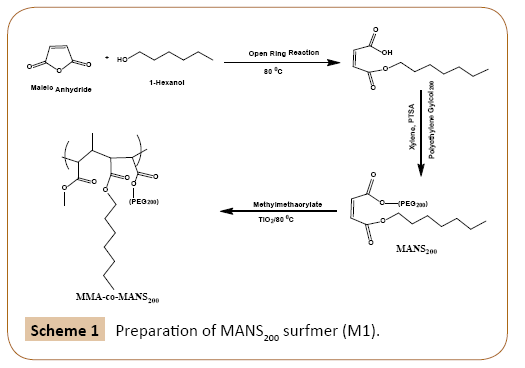
Scheme 1: Preparation of MANS200 Scheme 1 surfmer (M1).
The second step is the preparation of maleate surfmer (maleate diester) by esterfication of 0.1 mole of hemiester with 0.1 mole of PEG200. The reaction was performed in presence of 1% p-toluene sulphonic acid as a catalyst and xylene as a solvent. When the reaction completed, the solvent was distilled off under reduced pressure and the pure surfmer was obtained. Unreacted polyethylene glycol was removed by mixing the product with isopropanol and then extraction with a solution of 5% sodium carbonate. Isopropanol was then removed by distillation under reduced pressure in a rotary evaporator. The produced diester surfmer (MANS200) was left to dry overnight on anhydrous sodium sulphate and will be denoted as M1 in discussion.
Catalytic bulk polymerization of M1 and copolymerization of M1 and M2
Surfmer monomer (M1) 3.6 g and previously purified MMA (M2) 1.0 g with molar ratio of 1:1 was mixed in test tube of 20 ml capacity, then the catalyst samples TiO2 or V2O5 were added with different weight% (2, 10 and 20%) with respect to the total monomers weight. Dry nitrogen or oxygen were passed through the reaction mixture then the reaction test tube was tightly closed and put in adjusted water bath at the required temperatures (60, 80 and 100°C) for different times (2, 4, 8 and 12 h) and different molar ratios (1:2 and 2:1). When the reaction completed, the product container cooled to 25°C, opened and the produced copolymer was dissolved in acetone to separate copolymer solution from the catalyst by filtration. This copolymer precipitated by running in methanol then filtered and dried under vacuum at 40°C till stable weight. Maleate surfmer monomer (M1) also polymerized using the two catalysts in N2 and O2 atmosphere for comparison. The conversion% of product was calculated by the following equation:
Conversion%=(weight of copolymer/total weight of monomers) * 100
Characterization of non-ionic maleate surfmer M1, its polymer (PM1) and its copolymer (M1M2)
The prepared copolymers were characterized by using Gel Permeation Chromatography (GPC) to determine the numberaverage molecular weights (Mn), weight-average molecular weights (Mw), and polydispersity index (Mw/Mn) for different produced copolymer samples and as described previously [25]. Nuclear magnetic resonance 1H, 13C NMR spectra of the prepared non-ionic maleate sufmer, its homopolymer and co-polymers were recorded in chloroform using a Varian NMR-400-Mercury 400 MHz spectrometer with TMS as an internal standard. Fourier transform infrared (FTIR) spectra were measured using polymer/KBr disks with a Perkin Elmer 1500 Fourier transform spectrometer.
Interfacial tension measurements
The interfacial tension measurements were carried out using tensiometer K10ST, from KRUSS, at temperature of 298 K, by using the Du Nouy method. Different molar concentrations of the prepared non-ionic maleate surfmer and co-polymers were dissolved in toluene. The aqueous phase was a solution of distillated water. The interfacial tensions were quantified for 15 min after putting the oil and water phases in contact. The CMCs of the prepared surfactants were determined by the method adopted [35].
Results and Discussion
Polymerization of maleate surfmer and its copolymerization with MMA
Maleate surfmer homo-poymerized and copolymerized with methyl methacrylate through bulk technique with and without catalysts (TiO2 or V2O5) at different molar ratios, catalyst weight, reaction time, reaction temperature under O2 or N2 atmosphere.
Noncatalytic M1 polymerization and M1-M2 copolymerization: Table 1 represents the conversion% of bulk homo-polymerization of surfmer (PM1) and its copolymerization with M2 (M1M2 with molar ratio 1:1) in O2 and N2 atmosphere with/without TiO2 or V2O5 at 80°C for 4 h. The results indicate that the non-ionic maleate surfmer M1 gave nil polymer in both O2 and N2 atmospheres without catalyst [36]. While mixing of MMA monomer (M2) with maleate surfmer M1 increased the conv.% from nil to 1.0 and 19.4% in O2 and N2 atmospheres respectively producing copolymers M1M2O and M1M2N. Previous publications indicated that MMA can be polymerized in both O2 and N2 with higher conversion% in oxygen by oxidative polymerization mechanism [25,37]. These observations indicate that M1 and M2 are mostly activated thermally at the reaction temperature and produce free radicals according to Sudha et al. [38]. Scheme 2 suggests the free radical mechanism for bulk copolymerization of M1-M2 by producing M2 free radical (MMA*) which initiate M1 molecules and produce the first free radical unit (*M2-M1*) which capable of starting initiation and propagation steps in N2 atmosphere [39]. On the other hand, M1 homopolymerization and its copolymerization in O2 gave nil and 1% respectively mostly due to formation of epoxides on double bond (C=C) of M1. This epoxide is stable due to its conjugation with the two carbonyl (C=O) of two ester arms which can act as electron withdrawing groups. These stable epoxides cannot break to free radicals and thus block the created MMA free radicals and inhibit maleate surfmer homo-polymerization and its copolymerization with MMA. It can be concluded that MMA activated the double bond of maleate monomer in N2 while O2 form stable epoxides and block created free radicals. Also M1 and M2 have different activity with oxygen, the first inhibited while the second is activated in their polymerization process.
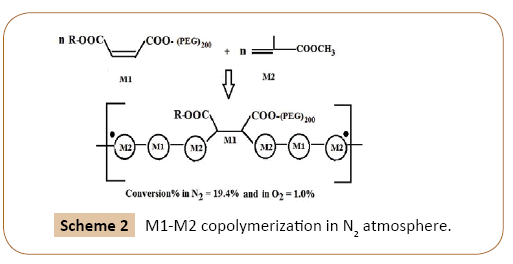
Scheme 2: M1-M2 copolymerization in N2 Scheme 2 atmosphere.
Table 1: Effect of metal oxide and reaction atmosphere (O2 and N2) on the conversion% of M1 homo-polymerization and M1M2 copolymerization at 80°C for 4 h.
| Nanocomposite Code | Catalyst Type and weight% | Atmosphere | Conv.% |
|---|---|---|---|
| M1 | No | O2 and N2 | 0.0 |
| M1M2N | No | N2 | 19.4 |
| M1M2O | No | O2 | 1.00 |
| M1TN (20%) | 20% TiO2 | N2 | 21.5 |
| M1TO (20%) | 20% TiO2 | O2 | 18.4 |
| M1M2TN (20%) | 20% TiO2 | N2 | 64.2 |
| M1M2TO (20%) | 20% TiO2 | O2 | 31.6 |
| M1M2VN (20%) | 20% V2O5 | N2 | 43.3 |
| M1M2VO (20%) | 20% V2O5 | O2 | 63.8 |
Catalytic M1 polymerization and M1-M2 copolymerization: Homo-polymerization of M1 using TiO2 and V2O5 in O2 or N2 atmospheres and its copolymerization with M2 at the same abovementioned conditions exhibited acceptable conversion% of polymers (Table 1). So, this work was to be intent on catalytic in situ bulk copolymerization of M1-M2 at different conditions and its comparison with M1 homo-polymerization results at the optimum conditions. The results on handing in Table 1 inform that, catalytic copolymerization of M1-M2 using TiO2 in N2 and O2 produce M1M2TN and M1M2TO copolymers with conv.% values 64.2 and 31.6% respectively at the abovementioned conditions. The conv.% increased due to TiO2 activity in N2 and O2 with values of ~ 44 and 30% relative to copolymers without catalyst (M1M2N and M1M2O respectively). It is clear that TiO2 have better concert in N2 relative to O2 environments in M1-M2 copolymerization process. Previous publication for bulk polymerization of MMA using CuO/TiO2 at 80°C for 5 h indicated that the conv% of PMMA were 20 and 24% using TiO2 in N2 and O2 environment respectively [25]. These previous results indicated the probability of an oxidative polymerization mechanism for MMA in such conditions [25]. Comparison between these previous results and present work confirm that TiO2 which is a semiconductor, can be activated thermally and creates its e-CB that capable of opening the olefin double bond of M1 and M2 to start the initiation step through free radical mechanism in N2 atmosphere. The concept that M1 also initiated by TiO2 is confirmed from its homopolymerization results in N2 and O2 with conv.% values of 21.5 and 18.4% respectively and nil without TiO2 from Table 1. These observations confirm that O2 may be forms stable epoxides with the olefin double bond of maleate monomer specially and the rate of initiation step by TiO2 is higher than the rate of epoxidation of C=C. So, propagation step retarded slightly and gave conv% value of 18.5% in oxygen environment.
On the other hand, results in Table 1 inform that V2O5 promotes copolymerization reaction in O2 better than in N2 atmospheres and the corresponding conv.% are 63.8 and 43.3, so the actual conv.% due to V2O5 activity are 24 and 62.8% relative to M1M2N and M1M2O respectively. It is concluded that TiO2 and V2O5 have different routes in this reaction. The electronic distribution of V2O5 surface mostly modified due to adsorption of oxygen and creates more active sites which accelerate initiation and propagation rates, so conv.% increased from 1% in O2 to 63.8% due to the catalytic effect of oxygen and V2O5. It is concluded that TiO2 is more dependable than V2O5 in this reaction because TiO2 without oxygen give the same conv% (~64%) using V2O5 in oxygen. Also, maleate homo-polymerization have different route and give lower conv% in O2 atmosphere versus MMA using catalysts. So, the effect of catalyst weight will be studied in N2 environment. Scheme 3 gives a suggestion for initiation and propagation mechanism of M1 and M1-M2 polymerization in N2 using TiO2 as a catalyst. Mostly, M1-M2 copolymer have an alternating units (-M1-M2-M1-M2-) in these conditions.
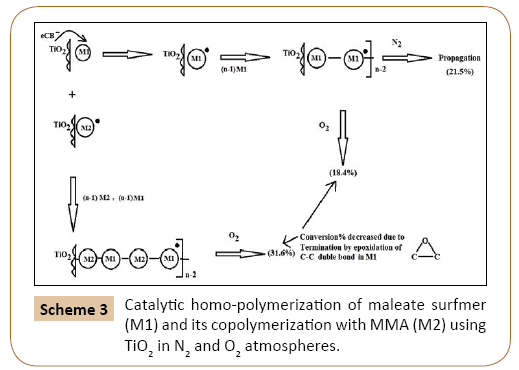
Scheme 3: Catalytic homo-polymerization of maleate surfmer (M1) and its copolymerization with MMA (M2) using TiO2 in N2 and O2 atmospheres.
Effect of catalyst weight%: Table 2 represents the conv.% of M1- M2 copolymerization using different weight% of TiO2 and V2O5 in N2 atmosphere. The conv.% increased from 19.4% without catalyst to 41.8, 56.3 and 64.2% using 2, 10 and 20 wt% of TiO2 and to 34.5, 47.2 and 43.3% using the same wt% of V2O5 respectively. The optimum weight% of TiO2 and V2O5 is 20 and 10% respectively.
Table 2: Effect of weight% of TiO2 and V2O5 catalysts in N2 atmosphere at 80°C for 4 h on conversion% of M1M2 copolymers.
| Nano-composite Code | Wt.% of Catalyst | Conv.% of Copolymers | Molecular weight distribution | ||
|---|---|---|---|---|---|
| αw/αn | αn | αw | |||
| M1M2TN(2) | 2% TiO2 | 41.8 | 2.16 | 116618 | 251280 |
| M1M2TN(10) | 10% TiO2 | 56.3 | 2.06 | 129649 | 267303 |
| M1M2TN(20) | 20% TiO2 | 64.2 | 2.1 | 143293 | 307294 |
| M1M2TO(20) | 20% TiO2 | 31.6 | 2.18 | 148064 | 323218 |
| M1M2VN(2) | 2% V2O5 | 34.5 | 2.2 | 76294 | 167133 |
| M1M2VN(10) | 10% V2O5 | 47.2 | 1.99 | 87149 | 173377 |
| M1M2VN(20) | 20% V2O5 | 43.3 | 2.06 | 95542 | 196320 |
| M1M2VO(20) | 20% V2O5 | 63.8 | 1.89 | 88888 | 168458 |
Molecular weight distribution of produced polymers indicates that as TiO2 wt% increased; αw and αn are increased but the polydespersity index (Δw/Δn) is nearly the same. These results indicate that number of active sites, number of polymer chains (Δn) and thus initiation and propagation rate are increased. Also, Δw and Δn increased by increasing V2O5 wt% but 10% give the maximum conv.% and better polydispersity index (Δw/Δn=1.99). These observations indicate better controlling using V2O5 mostly due to catalytic chain transfer [38]. So, conv% decreased by increasing wt% of V2O5.
Effect of M1/M2 molar ratio, reaction temperature and reaction time: Table 3 show the effect of M1/M2 molar ratios (1/2, 1/1 and 2/1), effect of reaction temperature (60, 80 and 100°C) and effect of reaction time (2, 4, 8 and 12 h) on conv.% of M1-M2 copolymerization in N2 atmosphere using TiO2 as catalyst. The optimum molar ratio of M1/M2 is 1:1. Also, conv.% due to molar ratio of 1:2 is better than 2:1 (45.8 and 30.5% respectively) as shown in Table 3. These observations confirm that M2 (MMA) initiate M1 and they may be repeated alternately (-M2-M1- M2-M1-) as suggested in Scheme 3.
Table 3: Effects of M1/M2 molar ratio, reaction temperature and reaction time on conversion% of M1M2 copolymer using optimum wt% TiO2 in N2 atmosphere.
| Nanocomposite Code | M1/M2 Molar Ratio | Temperature (°C) | Time (h) | Conv.% |
|---|---|---|---|---|
| M1/M2TN(20) | 1/2 | 80 | 4 | 45.8 |
| M1M2TN(20) | 1/1 | 80 | 4 | 64.2 |
| M1M2TN(20) | 2/1 | 80 | 4 | 30.5 |
| M1M2TN(20) | 1 | 60 | 4 | 27.2 |
| M1M2TN(20) | 1 | 80 | 4 | 64.2 |
| M1M2TN(20) | 1 | 100 | 4 | 30.5 |
| M1M2TN(20) | 1 | 80 | 2 | 37.4 |
| M1M2TN(20) | 1 | 80 | 4 | 64.2 |
| M1M2TN(20) | 1 | 80 | 8 | 62.2 |
| M1M2TN(20) | 1 | 80 | 12 | 32.5 |
Table 3 shows the conv.% at reaction temperatures 60, 80 and 100°C are 27.2, 64.2 and 30.5%. Also, conv.% after reaction time 2, 4, 8, 12 h are 37.4, 64.2, 62.2 and 32.5% respectively. The optimum reaction temperature and time are 80°C and 4 h. The conv.% decreases with longer reaction time and higher reaction temperature may be due to higher rate of chain transfer reaction [37] and/or epoxidation rate. Two ester groups of maleate surfmer unit can act as π-acceptor for the neighboring π-bond (C=C) electrons, which mostly resulted in stabilization of epoxides and thus inhibition of propagation step.
Characterization
Verification the chemical structure of the prepared non-ionic maleate surfmer (M1): The chemical structure of the prepared non-ionic surfmer (M1) was defined by FTIR, 1H and 13C NMR as shown in Figure 1a-1c respectively. Figure 1a shows the FTIR of M1 surfmer which indicates the presence of a band at 1733 cm-1 due to carbonyl group of the prepared diesters and two bands at 2870 and 2999 cm-1 due to symmetric and asymmetric methylene group. Disappearance of two characteristic bands at 1810 and 1780 cm-1 of the two arms of anhydride group of maleic anhydride confirms the formation of diester. Whilst the presence of OH stretching at 3372 cm-1 indicates that PEG is one of the constituents of the prepared monomer in addition to the band at 1100 cm-1 due to the ethereal bond C-O-C [31]. Also, the olefinic bond=CH2 still present and appeared at 1637 cm-1.
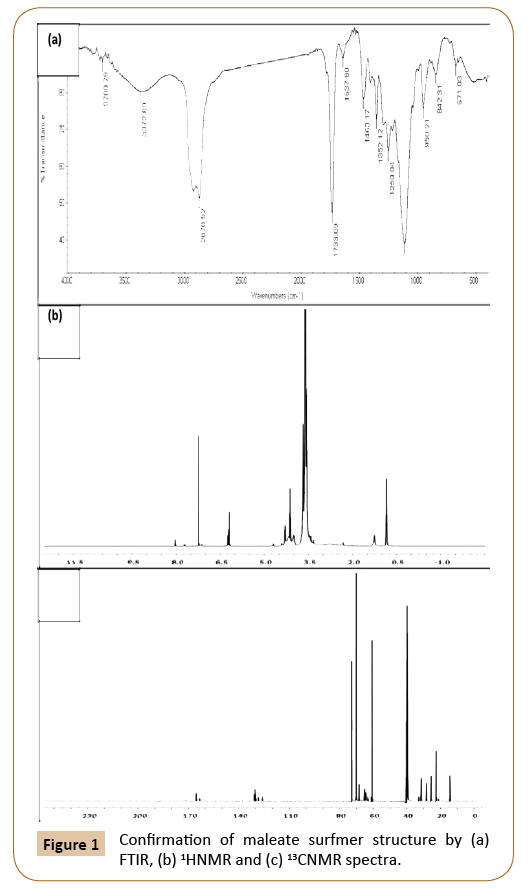
Figure 1: Confirmation of maleate surfmer structure by (a) FTIR, (b) 1HNMR and (c) 13CNMR spectra.
1HNMR of M1 in Figure 1b confirms M1 structure as follow: a chemical shift appears at ñ=0.851 and 1.261 ppm due to the terminal (CH3-) and (-CH2-)n of 1-hexanol respectively, the chemical shift resulted from the double bond of two protons of maleate appeared at 6.233 ppm. Three characteristic chemical shifts at 3.621, 4.13, and 4.701 ppm due to PEG moiety are appeared.
The chemical structure of the prepared surfmer is also justified through 13CNMR spectra as shown in Figure 1c. The figure shows chemical shifts at 13.8, 22.0, 30.9, 25.0, and 27.9 ppm due to the alkyl chain of hexanol (CH3CH2CH2CH2CH2-) respectively, a chemical shifts due to double bond of maleate surfmer at 130.0 ppm, a chemical shift of carbonyl group due to ester formation at 165 ppm, and finally chemical shifts of PEG at 64, 72, and 60 ppm. It can be concluded that all confirmation methods for the prepared M1 monomer structure are coincided together.
Confirmation of M1 homopolymer and M1-M2 copolymers using 13C and 1HNMR spectra: Maleat surfmer was homo-polymerized using 20% w/w TiO2 and V2O5 as catalysts in nitrogen atmosphere at 80°C for 4 h and produce M1TN and M1VN respectively. The 1HNMR spectra of M1TN and M1VN samples and 13C NMR of M1TN sample are shown in Figure 2a-2c respectively. It can be seen from 1HNMR that the spectrum of M1TN and M1VN differs from that of the monomer M1 (Figure 1b) in terms of the appearance of a triplet band at 2.5 ppm which represents the (–CH-CH-) protons in the polymer backbone and disappearance for the band of double bond maleat surfmer (-CH=CH-) which confirm homopolymerization of M1. The 13C NMR in Figure 2b for M1TN sample shows a chemical shift at ñ=30.896 ppm due to polymerized (-CH-CH-) of maleat surfmer and confirm 1HNMR results.
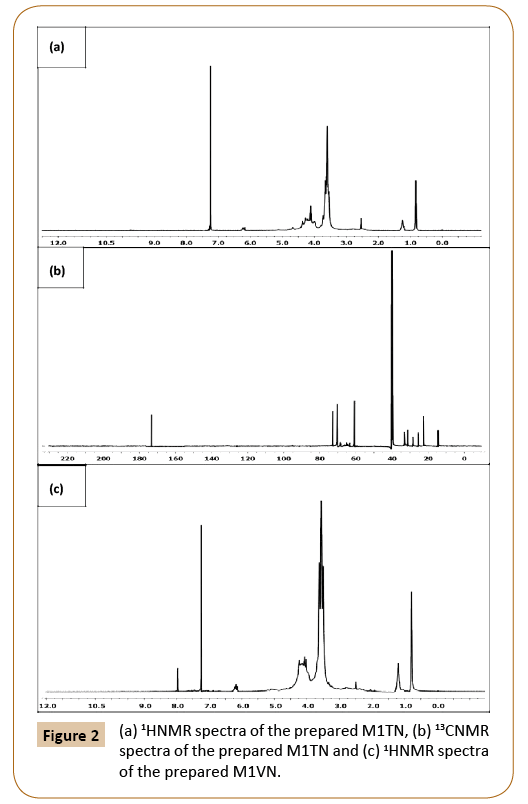
Figure 2: (a) 1HNMR spectra of the prepared M1TN, (b) 13CNMR spectra of the prepared M1TN and (c) 1HNMR spectra of the prepared M1VN.
The maleat surfmer (M1) also copolymerized with methyl methacrylate (M2) with molar ratio of 1:1 in presences of TiO2 and V2O5 under oxygen or nitrogen atmosphere at 80°C for 4 hrs. 1HNMR spectra of copolymers (M1M2TN and M1M2VN) and 13C NMR of M1M2TN are presented in Figure 3a-3c respectively. From the comparison of M1M2TN copolymer with M1TN homo-polymer, it is of interest to mention that -CH- band due to backbone of surfmer shifted from 2.5 ppm in M1TN to 2.719 ppm in M1M2TN and be stronger and broader band. In addition, disappearance of the two olefnic protons (CH=CH) at ppm confirm copolymerization of surfmer with MMA. The chemical shift of the (-OCH3) of acrylate appeared at ppm and also, the characteristic bands of PMMA which appeared between 0.0 and 2.0 ppm confirm copolymerization of MMA. The abovementioned results confirmed by 13CNMR of copolymer (M1M2TN) in Figure 3c. From this figure it can be observed a new chemical shifts at ppm due to copolymerization, chemical shift at and 52.3 ppm due to the methyl group (CH3) of hexyl chain and methoxy (OCH3) of methyl methacrylate respectively.
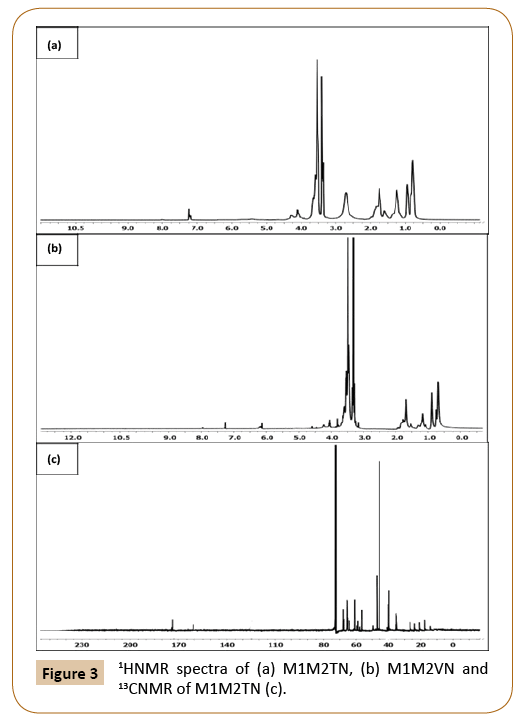
Figure 3: 1HNMR spectra of (a) M1M2TN, (b) M1M2VN and 13CNMR of M1M2TN (c).
It is concluded that 1HNMR of M1 contain -CH=CH- characteristic band at chemical shift of 6.233 ppm. This band disappears in 1HNMR spectra of M1 homo-polymer and M1M2 copolymers. 1HNMR of M1 contain (-CH2-)n and terminal –CH3 characteristic bands due to hexyl chain at 1.261 and 0.851 ppm respectively. These bands still present in all spectra of M1 homo-polymer and M1M2 copolymers. These observations confirm homopolymerization of M1 and its copolymerization with MMA. PMMA have singlet bands at 0.85, 1.03, 1.22 ppm due to (rr), (mr) and (mm) respectively. Multiple bands appeared between 1.8 -2.3 ppm due to (rrr), (mrr), (mrr) and (mrm) respectively. These bands appear in samples M1M2VN and M1M2TN and disappear in samples M1M2VO and M1M2TO spectra. The band of –OCH3 due to PMMA appear at 7.278 ppm in spectra of M1M2VO and M1M2TO but sharply decreased in M1M2VN and M1M2TN. These observations may indicate that O2 and N2 environments have different effect on M1-M2 repeating. The two monomers M1 and M2 may be repeated as M1M2M2M2M1 in N2 which resulted in appearing of the multiple bands. On the other hand, these multiple bands disappear in spectra of M1M2TO and M1M2VO. Also –OCH3 band appeared in spectra of these samples. These observations may indicate that M1 and M2 are repeated in their copolymer as M1M2M1M2. It is concluded that O2 environment affect as co-initiator which give more controlled enchainment process.
Thermogravimetric analysis (TGA): Figure 4 shows the thermogravimetric analysis of pure PMMA, M1-M2 copolymer at optimum conditions using 20% titanium oxide in nitrogen atmosphere (M1M2TN) and using 10% vanadium pentoxide in oxygen atmosphere (M1M2VO). The figure shows the higher thermal stability of the two copolymer composite samples relative to PMMA.

Figure 4: Thermogravimetric analysis of pure PMMA, M1M2TN and M1M2VO.
Scanning and transmission electron microscope: Figure 5a- 5d show TEM of pure PMMA and SEM of M1M2TN sample with different magnification factors (X50, X200 and X2000) respectively. TEM of PMMA show pure film of PMMA matrix. SEM of M1M2TN in Figure 5b show interacted TiO2 particles with M1-M2 copolymer matrix. This interaction be clear by higher magnification in Figure 5c and 5d. This figure is clearly show homogeneous copolymer matrix centered around points which are mostly the catalyst particles.
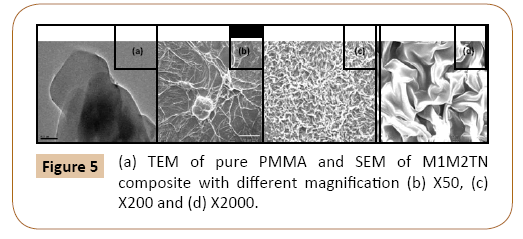
Figure 5: (a) TEM of pure PMMA and SEM of M1M2TN composite with different magnification (b) X50, (c) X200 and (d) X2000.
Interfacial properties for prepared surfmer and its corresponding copolymer: The effect of the surfmer and its copolymer concentrations (Ln C) on the reduction of the interfacial tension (γ) of the toluene-water interface at 298 K is showed in Figure 6. Two curves presented similar expected behavior for surfactants. First, a linear decreasing in the interfacial tension is observed with increasing the surfactants concentration, which means that the adsorption of the prepared surfactants molecule at the toluene-water interface is in accordance with the Gibbs adsorption isotherm. The interfacial activity was available by the rate of the interfacial tension decreasing to the increasing in the natural ln of the surfactants concentration, and it was got from the angular coefficient of the linear curves in γ–Ln C plot.
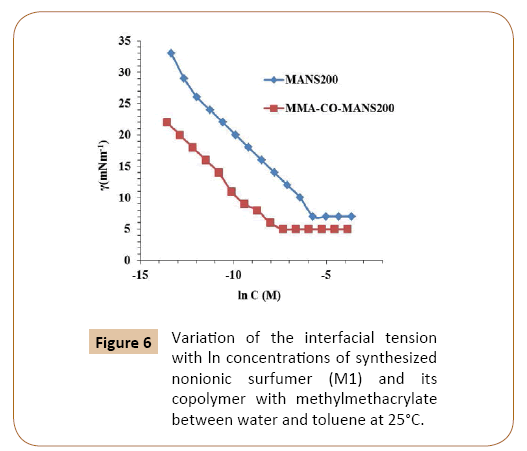
Figure 6: Variation of the interfacial tension with ln concentrations of synthesized nonionic surfumer (M1) and its copolymer with methylmethacrylate between water and toluene at 25°C.
a=-dγ d LnC
where: a is the interfacial activity, N/m; γ is the interfacial tension, N/m; and C is the concentrations of prepared surfactants mol/ kg. From a certain concentration, the interfacial tension value became constant. It was assumed that the saturation of the prepared surfactants molecule at the interface was reached and micellization took place, by the self-aggregation of surfactants molecules. The CMC value was got by the intersection of two segments prolongation in γ–Ln C plot. According to data obtained from interfacial tension curves and listed in Table 4, it can observed that, for the prepared copolymer, the interfacial tension for them less than the corresponding prepared surfmer, this may be due to increasing the hydrophobic portion which leads to easily oriented to the interface and adsorbed on it which leads to a continuous shift of the CMC to lower values [40].
Table 4: Interfacial properties for the synthesized surfmer and its copolymer from interfacial tension measurements at 25°C.
| Surfactants | CMC ×104 (mol L-1) | γCMC(mNm-1) | ßCMC(mNm-1) | Ómax ×1010(mol cm-2) | Amin(A2) |
|---|---|---|---|---|---|
| M1 | 32.70 | 7 | 29.1 | -1.22 | 135.25 |
| M1M2TN(20) | 6.48 | 5 | 31.1 | -1.19 | 139.14 |
The maximum surface excess (Γmax) was calculated from the relationship:

Where (-δγ/δ ln C)T is the slope of γ versus ln C plots at a constant absolute temperature T and R=8.314 J.mo1-1.K-1. The data of Γmax are shown in Table 5. For the surfmer the Γmax values are higher than the corresponding values for the copolymers derived from them. This may be attributed to a higher degree of packing for the molecules of the surfmer than that of the molecules of the corresponding polymeric surfactant.
Table 5: The free energy of micellization, the free energy of adsorption and the hydrophobic-lipophilic balance (HLB) for the synthesized surfactants.
| Surfactants | ΔGmic(kJ mol-1) | ΔGAds.(kJ mol-1) | ΔGmic-ΔGAds. | HLB |
|---|---|---|---|---|
| M1 | -14.16 | -16.53 | 2.37 | 10.47 |
| M1M2TN(20) | -18.16 | -20.77 | 2.61 | 8.29 |
The Γmax values were used for calculating the minimum area Amin in nm2 per molecule at the interface using the following equation:

Where, N is Avogadro's number, the values of the Amin for the pared surfactants calculated and listed in Table 4. Amin for prepared copolymeric surfactant is higher than the corresponding surfmers; this may be due to increasing its molar mass which leads to increase in the radius of gyration of the molecule [41,42].
The standard free energy of micellization (ΔGmic) determination has played an important role in developing a clear understanding of the process of micellization, which is important for discerning clarification, the impacts of effects of structural and environmental factors on the value of the CMC and for predicting the effects on it of new structural and environmental variations [43]. It can be determined by the following equation:

By analyzing the values of standard free energy of micellization (ΔGmic) in Table 5, it may conclude that, the values of standard free energy of have negative charge this mean that the micellization process is spontaneous (-ΔGmic). The values of ΔGmic for MMA-co- MANS200 more negative than the corresponding surfumer and this may be due to increasing the hydrophobic moiety, the increase in hydrophobic chain length increases its distortion motion in the solution, so the free energy increases. The increase of the free energy expressed by -ΔGmic evidence this concept.
The Standard free energy of adsorption (ΔGads) was calculated by the use of ΔGmic values from the relationship [44]:

i.e. the πCMC Amin product expresses the work involved in transferring the surfactant molecule from a monolayer at zero surface pressure to the micelle. The ΔGad values are all negative as listed in Table 5 and are more negative than ΔGmic, indicating that adsorption at the interface is associated with a decrease in the free energy of the system.
The differences between ΔGmic and ΔGad from previous equation can be written as
0.6023Amin πCMC=ΔGmic - ΔGad
where the product Amin πCMC expresses the work involved in transferring a surfactant molecule from a monolayer zero surface pressure to a micelle; ΔGmic and ΔGad values are listed in Table 5. It is apparent that the work of transfer, which measures the ease of adsorption to form a monolayer at zero surface pressure relative to ease of micellization, shows observed change with increasing the hydrophobic moiety for copolymer than the corresponding surfmer. The positive values of ΔGmic - ΔGad reflect that, the prepared surfactants are more readily adsorbed at interface. This in turn could account for investigating these surfactants in petroleum application.
The HLB values were calculated using the general formula for non-ionic surfactants,
HLB=[MH/(MH+ML)]* 20
where MH is the formula weight of the hydrophilic portion of the surfactant molecule and ML is the formula weight of the hydrophobic portion. The calculated HLB listed in Table 5. When the hydrophobic moiety increases by copolymerization, the HLB decrease and this give conception on good solubility of copolymers in oil.
Conclusion
Nonionic maleate surfmer was synthesized in two steps and used as a monomer (M1). The first is the ring opening by hexyl alcohol and the second is the esterfaction reaction with PEG200. The chemical structure of the prepared sufmer M1 was confirmed by FTIR, 1H and 13CNMR spectroscopy. M1 homo-polymerization give nil conv.% but copolymerized with MMA with conv.% of 19.4 and 1% in N2 and O2 atmosphere respectively without catalyst. Also, M1 homo-polymerized in presence of TiO2 as catalyst in N2 and O2 with conv.% of 21.5 and 18.4% respectively. It is also copolymerized with methyl methacrylate in presences of TiO2 and V2O5 as catalyst in N2 and O2 at 80°C for 4 hours. The chemical structure of the prepared clean polymers was confirmed by FTIR, carbon and hydrogen nuclear magnetic resonance (13C and 1HNMR) and characterized by gel permeation chromatography (GPC). The thermal stability of pure PMMA and the composites M1M2TN and M1M2VO show higher thermal stability of composites relative to PMMA. Also, TEM of PMMA and SEM of M1M2TN confirm a homogeneous enchainment of M1-M2 copolymer centered around TiO2 catalyst particles. The optimum conditions resulted in 64.2% and 63.8% conversion using 20% TiO2 in N2 and 10% V2O5 in O2 respectively at 80°C after 4h with M1/M2 molar ratio of 1:1.